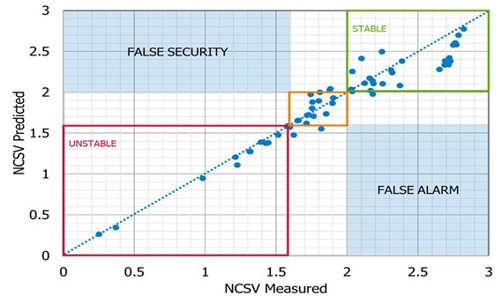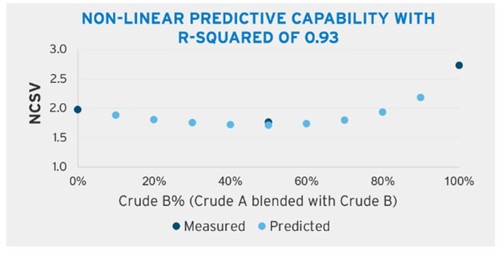2021 AFPM Annual Meeting Virtual Edition: Predictive model for blend stability analysis
JEFFREY HUBBARD, JILLIAN DAVIDSON and DANIEL DREYER, Nalco Water
If not managed correctly, the blending of incompatible crude oils can potentially lead to a variety of transportation, storage and upgrading challenges. With the introduction of IMO 2020 regulations, the use of very low-sulfur fuel oil (VLSFO) blends has become more prevalent, and similar challenges associated with preparing viable, compatible blends have emerged. In addition, crude oil incompatibility can increase the stability of water in oil emulsions, presenting a significant challenge to refinery energy consumption, equipment fouling, crude throughput, wastewater compliance and asset integrity.
Unfortunately, the relative stability of a hydrocarbon blend does not directly correlate to its asphaltene content, making it fairly challenging for a refinery’s crude purchasing and planning department to mitigate or predict. Compatibility is vetted based on previous operational experience and arduous, time-consuming laboratory test methods, such as colloidal instability index (CII), crude stability index (CSI) and the oil compatibility model (OCM) that require physical samples be collected and analyzed. The runtime of existing laboratory methods is often prohibitive when crude buyers must consider multiple blend permutations or initiate a transaction immediately. In addition, most of the current models utilized by the industry are not viable for analyzing oils that have a low content of asphaltenes (≤ 0.5%), presenting a further challenge to effectively mitigate the risk of blending light oils.
To mitigate these challenges, a fast and reliable simulation is required by the industry to effectively predict the stability of blended hydrocarbon streams. To be effective, the output of the simulation must correlate to observed blend stabilities and account for the observation that blend stability is more complex than a weighted linear interpolation of individual oil stability values. Nalco Water has developed a new predictive analytical model that takes into account both these considerations.
Residual stability analysis. Nalco Water’s Residual Stability Analysis (RSA) measures the stability of asphaltenes in solution and may also help identify non-compatible oil blends. A number of propriety changes to the method prescribed by ASTM D-7157 have been implemented to allow for analysis of oils containing less than 0.5% asphaltenes, to minimize interferences from high melting point waxes and to obtain greater sensitivity.
Three outputs are reported from the RSA test. The Nalco Crude Stability Value (NCSV) is a measure of overall stability. Higher NCSV values suggest a more stable blend. Af is the asphaltene solubility, or how stable the native asphaltenes are in the oil sample. Increasing values of Af correspond to increasing solubility of the asphaltenes in solution. The oil solvency power (Sf) can be used to measure how well the matrix can stabilize additional asphaltenes. Higher Sf values suggest the oil will be more solvating towards additional asphaltene content.
A general guideline for the assignment of relative stability based on the NCSV is outlined in TABLE 1.
|
NCSV |
Stability assignment |
|
< 1.4 |
Instability likely |
|
1.4–1.6 |
Instability possible |
|
1.6–2.0 |
Monitoring needed |
|
> 2.0 |
Stability likely |
TABLE 1. Nalco crude stability value (NCSV) classification.
Predictive model for blend stability. Nalco Water has developed a simulation model of its RSA method called the CrudeFlex Blend Stability Service, providing a refinery or fuel blender with a predictive tool to analyze the potential for incompatibility. Using stability properties of individual oils, this model can provide the resulting NCSV, Af and Sf values of any blend combination instantaneously. The stability values of individual oils can be selected from library values or inputted from spot testing of a batch. The library can be used to preemptively screen opportunity feeds without having to obtain and analyze a sample, while spot testing increases accuracy by removing variation among batches.
The predictive model is highly accurate with R2 > 0.99 for predicted NCSVs vs. measured NCSVs. FIG. 1 shows the model validation data set for NCSV, where the laboratory measured values are on the horizontal axis and the predicted values are on the vertical axis. The regions of defined risk are outlined showing stable and unstable blends. The box in the center marks the region where the stability value is too close to the boundary to assess the actual impact on the system. The data points remain close to the diagonal line of an exact match with the laboratory test result, and well away from the shaded regions of false alarm where unnecessary mitigation action is taken or of false security where asphaltene precipitation is allowed to negatively affect the unit.

FIG. 1. NCSV validation.
The predictive model can also effectively account for the non-linear crude stability behavior of light oils with low asphaltene content. An R2 value of 0.93% was obtained between predicted and measured stability values of various blends of WTI and Bakken crude oil (FIG. 2).

FIG. 2. Predictive accuracy for light oil blends.
Takeaway. There is now a way to predict the complex non-linear relationships for asphaltene stability in crude or VLSFO blends. The ability to instantaneously evaluate the stability of numerous blends with high accuracy allows for diminished risk when insourcing opportunity crudes and provides guidance on how to safely blend various streams. Consequently, refiners and fuel blenders can capture the financial benefits of refining more opportunity crudes with confidence and avoid the costly impacts of asphaltene stability.
About the authors:
JEFFREY A. HUBBARD is a Staff Scientist, Downstream Research—Automation, for Nalco Water. He has 15 years of research experience with Nalco Water, where he has spent time as a member of the Analytical Technologies, Refinery Process and Automation research groups. His current role includes supporting the CrudeFlex blend stability model—which he developed—and developing automation platforms and sensors for refining and petrochemical applications. Hubbard holds a BS degree in chemistry from the University of Texas at Austin.

JILLIAN DAVIDSON is a Program Leader in the Refinery Process Group at Nalco Water, managing a team of researchers focused on providing technical solutions to refinery fouling and phase separation issues. Dr. Davidson has six years of experience in the oil and gas industry with a primary focus on synthetic innovation to improve chemical additives for accelerated oil and water separation. A recent series of products launched under her purview includes the Overlay technologies, which can be utilized for enhanced interface control at the desalter. This product line has revolutionized Nalco’s chemical approach towards improving performance on challenged units.

DANIEL R. DREYER earned a BS degree in chemistry from Wheaton College in Illinois and a PhD in chemistry from the University of Texas at Austin. He has been with Nalco Water for 7 years, working on a variety of R&D development projects in both the upstream and downstream areas of the energy industry. In his current role, he is part of the Fuel Additives and H2S scavengers R&D team, with a focus in the development and testing of additives for renewable fuels and biofuels, novel H2S scavengers, and blending strategies and additive solutions for very low-sulfur fuel oil (VLSFO) blends.







Comments